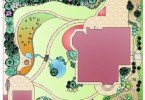Drop watering in a greenhouse
Drip irrigation in the greenhouse is the best way to moisten the soil, because the greenhouse is always built based on intensive production. In other words, having invested in the construction of the greenhouse, the owner wants to get a return in the form of maximum productivity per square meter. And the experience of vegetable growers from all countries clearly says that only a drip irrigation system for greenhouses can provide such productivity.
Content
- General scheme of drip irrigation system
- Why plants like drip irrigation
- Types of drip irrigation systems
- Buy or do it yourself – which is better
- Equipment Care
General scheme of drip irrigation system
Any drip system consists of a tank and irrigation lines themselves. Additionally, it can include a main pipeline, filters, automation units, a fertilizer application unit, fittings and accessories, controllers, sensors, valves.
The capacity can be any – a tank, a barrel, a tank. Craftsmen even fit for this inflatable children’s pools. The only requirement for the tank is the ability to install it above the ground so that water can flow into the hoses by gravity.
It is more difficult to determine irrigation lines, because there are many options for their designs. An irrigation line is a hose, pipe or tape with droppers built into them.
Welded polyethylene tape – microscopic holes are left on the seam during welding, through which water oozes droplets. There are no droppers per se at all. Advantages – the cheapest line. Disadvantages – barely enough for one season.
Tape with droppers – a seamless tape made of dense polyethylene with built-in or external droppers. Advantages – inexpensive, on soft soils lasts for 2-3 seasons. No particular shortcomings by gardeners.
Seamless tubes with droppers – HDPE pipe with droppers of various designs already built in the factory or installed independently. Advantages – enough for a long time, careful filtering is not required, clogged droppers can be replaced. Disadvantages – the highest cost in comparison with the rest.
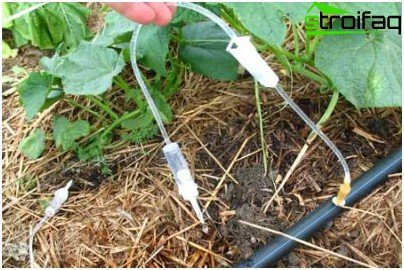
An external dropper on a long hose is still rarely found on sale, but it is very convenient for lovers
Why plants like drip irrigation
Drop watering increases the yield of vegetables in the greenhouse by at least 50%. This is due to the fact that plants grow faster and do not get sick with common diseases, for example, tomatoes have almost no late blight.
Why do plants feel better with such watering? The fact is that the constant optimal soil moisture is very “liked” by useful soil microorganisms such as actinomycetes, nitrifying bacteria and nodule bacteria. This useful soil fauna ceases to work on dry or waterlogged soil. But if constant hydration, bacteria and fungi work 24 hours a day, extracting vital nitrogen for plants and at the same time increasing their immunity.
As for late blight and other fungal diseases, the basis for the spread of which is droplets of water on the leaves, when watering directly into the root system, they have no chance to “crawl” not only throughout the greenhouse, but even through a single plant.
Types of drip irrigation systems
- Simple (no automation)
It must be turned on for several hours a day on and off. Even such a simple system makes labor easier, saves time and effort..
- Semi-automatic
The best option. Watering starts and ends daily without your participation, for this an electronic starting device is built into the system. You just have to fill the tank with water as it decreases.
- Automatic
Water is drawn from the water intake by itself, it is heated in the sun all day, and at night the photocell is activated, and it spills out in droplets on the beds. As soon as 2 liters pour out under each root (the volume is regulated by you), the water closes. You only need to assemble the system at the beginning of the season and carry out inspection from time to time.
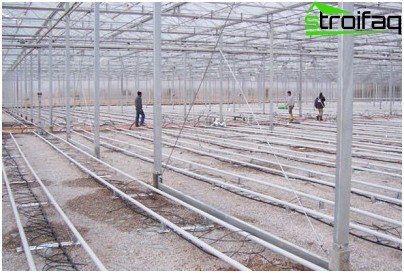
In any country in the world, industrial greenhouses are now under drip irrigation – this greatly reduces the consumption of water and electricity
Buy or do it yourself – which is better
If a few years ago it was possible to advise to build drip irrigation in a greenhouse on your own, from improvised means, now that the market is already full of many very affordable ready-made kits, the sheepskin is no longer worth the hassle. For example, the price of a semi-automatic device of domestic production for 50-60 bushes (this is just an amateur medium-sized greenhouse) is around three thousand rubles. It’s cheaper than buying a controller on the radio market itself, and in stores for summer residents – tapes, droppers and fittings.
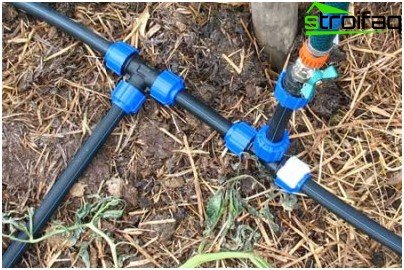
Sometimes you have to make a complex system with many fittings
Equipment Care
The most common problem is clogging of pipes, tapes and droppers. They can clog for a number of reasons:
- Bacteria and algae, zooplankton, various larvae multiplied in water.
- Various chemical compounds were deposited on the walls of the system. First of all, it can be calcium and magnesium, sometimes iron. Fertilizers diluted in water may also precipitate and clog openings..
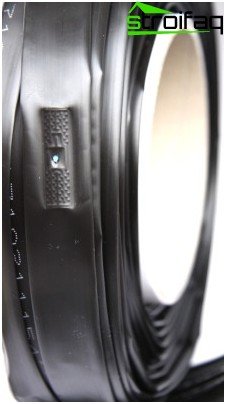
Black tape with integrated droppers to prevent algae from multiplying inside
Water treatment, which can be mechanical, chemical and biological, helps fight blockages..
- Mechanical involves installing filters in the system in nodal places and flushing the entire system under low pressure while opening the plugs at the ends of the lines. Clogged droppers will have to be replaced.
- Chemical is the disinfection of water by its chlorination. Small doses of chlorine, harmful to unicellular organisms, are harmless to higher plants. Chlorine is added for 20 minutes a day at a concentration of 10-20 mg per liter of irrigation water.
Instead of chlorine, you can add copper sulfate (2 mg / l) or acid – sulfuric, nitric, phosphoric. The amount of acid is added so that the pH of the water becomes 2.0.
- Biological – other microorganisms serve as an obstacle to the multiplication of protozoa and algae. Biological treatment products can be found in specialized stores.
Install a drip irrigation system for greenhouses and water it in a mode convenient for its green inhabitants, and not for you – that is, little by little at night. They will thank you for such care with good harvest increases..


